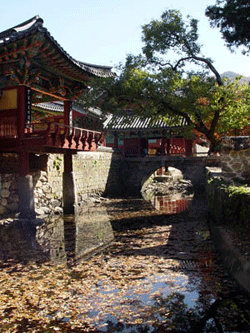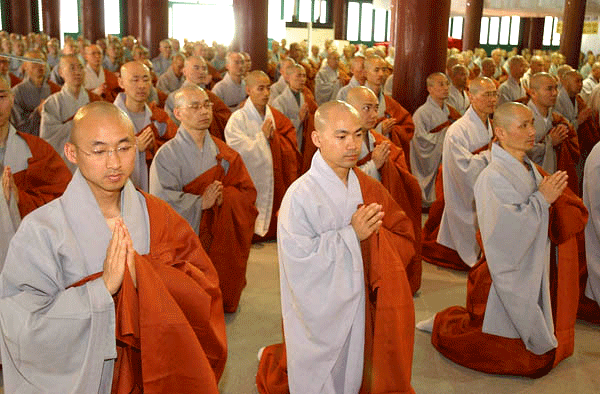History of Buddhism in Korea

Buddhism was adopted as the official state religion in the Goguryeo, Silla and Baekje kingdoms during the Three Kingdoms Period (57 B.C.E. – 668 C.E.), and the Unified Silla kingdom(668-935) succeeded in applying Buddhism as the psychological force for the unification of the peninsula.
During the Unified Silla Period, Buddhism played a preeminent role in cultural development, resulting in the construction of such world-renowned historical sites as Bulguksa Temple and Sokguram Grotto. In addition, the world’s earliest known printing using woodblocks for the Mugujeonggwang Dharani followed by the first metal type print for the Jikjisimcheyojeol(Jikji in short), a Buddhist sutra, at Heungdeoksa Temple (in today’s city of Cheongju) attest the advanced development of the culture. Pre-dating Guttenberg by 78 years, the text was printed in 1377 C.E. and it is currently in the possession of the French National Library. It was designated a UNESCO “Memory of the World” in 2001. The sutra is an outline of Buddhist teachings necessary for spiritual development as well as indications as to how to pass on the Dharma, including religious songs, chanting, engravings, writings, glossaries of technical terms, and Seon verbal combat.
During the Unified Silla Period, the teachings of Chan (known as Zen in Japanese and Seon in Korean) were brought from China and led to the development of a Seon order, thereby adding another dimension to philosophical advance and eventually providing a psychological foundation for the post-Silla period, the Goryeo Dynasty (918-1392).
Goryeo, too, adopted Buddhism and it became a unifying factor and the grounds for further national and cultural flourishing. In particular, Goryeo followed the teachings of Unified Silla National Monk Doseon (827-898) and had temples built on famous mountains around the nation, adding further impetus to the dissemination of the Dharma. Also during Goryeo, the Tripitaka Koreana was carved into more than 80,000 woodblocks as an offering for national protection from outside forces and invasion, and Buddhism gave birth to such creative national festivals as the P’algwanhoe and the Yeondeunghoe (Lotus Lantern Festival).
During Goryeo, the number of Buddhist orders diversified and flourished. However, the increasing economic and political influence of the monks led to condemnation by the common people, and, ignored by the aristocracy, Buddhism came into a period of political repression with the ensuing Joseon Dynasty (1392-1910).
During Joseon, Neo-Confucianism rapidly gained favor, and although royalty continued to practice Buddhism privately, Confucianism ruled administration and society. Under a continuing policy of repression, Buddhism was banished to the mountains and monks were generally treated harshly. However, this banishment proved to be quite valuable to Buddhism in two respects: the temples became centers for the communal flourishing of Seon practice, and Buddhism established strong bonds with the common people.
During the first half of the 20th century, Korean Buddhism necessarily fell under the influence of Japanese Buddhism during the Japanese Occupation (1910-1945). It was only after liberation in 1945 that traditional Korean Buddhism could once again be established in the form of Korean Seon and that the Jogye Order to once more come to the fore.
Jogye Order of Korean Buddhism

Jogye Order is the representative order of traditional Korean Buddhism with roots that go all the way back 1,200 years to Unified Silla National Master Doui, who brought Seon and the practice taught by the Sixth Patriarch, Huineng, from China about 820 C.E. In 826, the “Nine Mountains of Seon” adopted the name “Jogye-jong” and all were instrumental in the development of the nation during Unified Silla and thereafter.
During Goryeo, National Masters Bojo Jinul and Taego Bou led major Seon movements. The Jogye Order was thus established as the representative Seon order until the persecution of the Joseon Dynasty.
For nearly 500 years, however, Buddhism was repressed in favor of Confucianism. During the reign of Joseon King Sejong (r. 1418-1450), two sects were formed, one of all the doctrinal schools and another of all the Seon schools. These were then temporarily disbanded under the reign of King Yonsangun (r. 1494-1506), resulting in great confusion. However, during the Hideyoshi invasions of the late 15th century, National Masters Seosan and Samyeong raised armies that protected the nation which improved the situation of Buddhism for a time. However it was not until the political reforms of 1895 that monks were permitted in the cities again. Then in 1899, under the leadership of Seon Master Gyeongheo (1849-1912), monks petitioned from Haeinsa Temple to reestablish the traditions and the philosophical basis for a reconstructed Buddhist order. Eventually, the Wonjong and Imjejong (Linji) orders were founded, and attempts were made to revive the doctrinal schools and to reestablish activities in the cities, but these movements were soon suppressed following the Japanese Occupation in 1910.
Leading resistance and liberation fighters against the occupying forces included such famous monks as Yongsong and Manhae, and efforts continued to keep Korean Buddhist traditions alive. In 1921 the Sonhakwon Seon Meditation Center was established and in 1929, a Monks’ Conference of Joseon Buddhism was held. In 1937, a movement for the establishment of a Central Headquarters began which was successful with the building of the Main Buddha Hall of Jogyesa Temple in Seoul in 1938. Finally in 1941 the Joseon Buddhism Jogye Order which was distinctly Korean and free from Japanese influence, was established. This was the first legal Buddhist order in modern Korea and the precursor of today’s Jogye Order of Korean Buddhism.
Following liberation from Japan in 1945, Seon monks who had preserved and cherished Korean Buddhist traditions began a purification drive to re-establish the traditional celibate orders and take back the temples from married monk, a remnant of the Japanese Occupation. Finally, in 1955 the Jogye Order was established centered around celibate monks; however, as a result of mediation between the elder monks and the government, already-married monks were also included.
On April 11, 1962 Jogye Order of Korean Buddhism was officially established with three main goals: training and education; sutra translation into Korean from Chinese characters; and propagation. These goals continue to guide the Jogye Order today as well. It was in 1947-1949 that a group of monks at Bongamsa Temple began a movement advocating “Living According to the Teachings of the Buddha” and this provided the opportunity for the establishment of fundamental principles and traditions as well as the accepted ceremonies of the order.
– Source : www.koreanbuddhism.net





Comments are closed.